Critical Evaluation of System Theory and PR Practitioner's Role
VerifiedAdded on 2021/10/09
|12
|3562
|79
Essay
AI Summary
This essay critically evaluates the statement that the system theory, as proposed by Grunig et al., exemplifies the boundary-spanning role of PR practitioners within an organization. The essay begins by introducing the concept of public relations and its theoretical underpinnings, emphasizing the significance of the systems theory in PR practice. It delves into the open systems theory, particularly the organismic model, highlighting how it equips PR practitioners to understand and manage external influences on an organization. The essay references the contributions of Cutlip, Centre, and Broom, as well as Tench and Yeomans, to illustrate how the open systems approach enables effective communication and strategic advisory roles for PR practitioners. Furthermore, it examines the role of cultural hegemony and how power dynamics play out in modern-day corporate organizations. The analysis includes an exploration of Antonio Gramsci's views on cultural hegemony, discussing how the ruling class's ideologies and values influence the workplace. The essay emphasizes the importance of PR practitioners in fostering relationships and adapting to changing trends, ultimately concluding that their boundary-spanning roles are crucial for organizational effectiveness and growth.
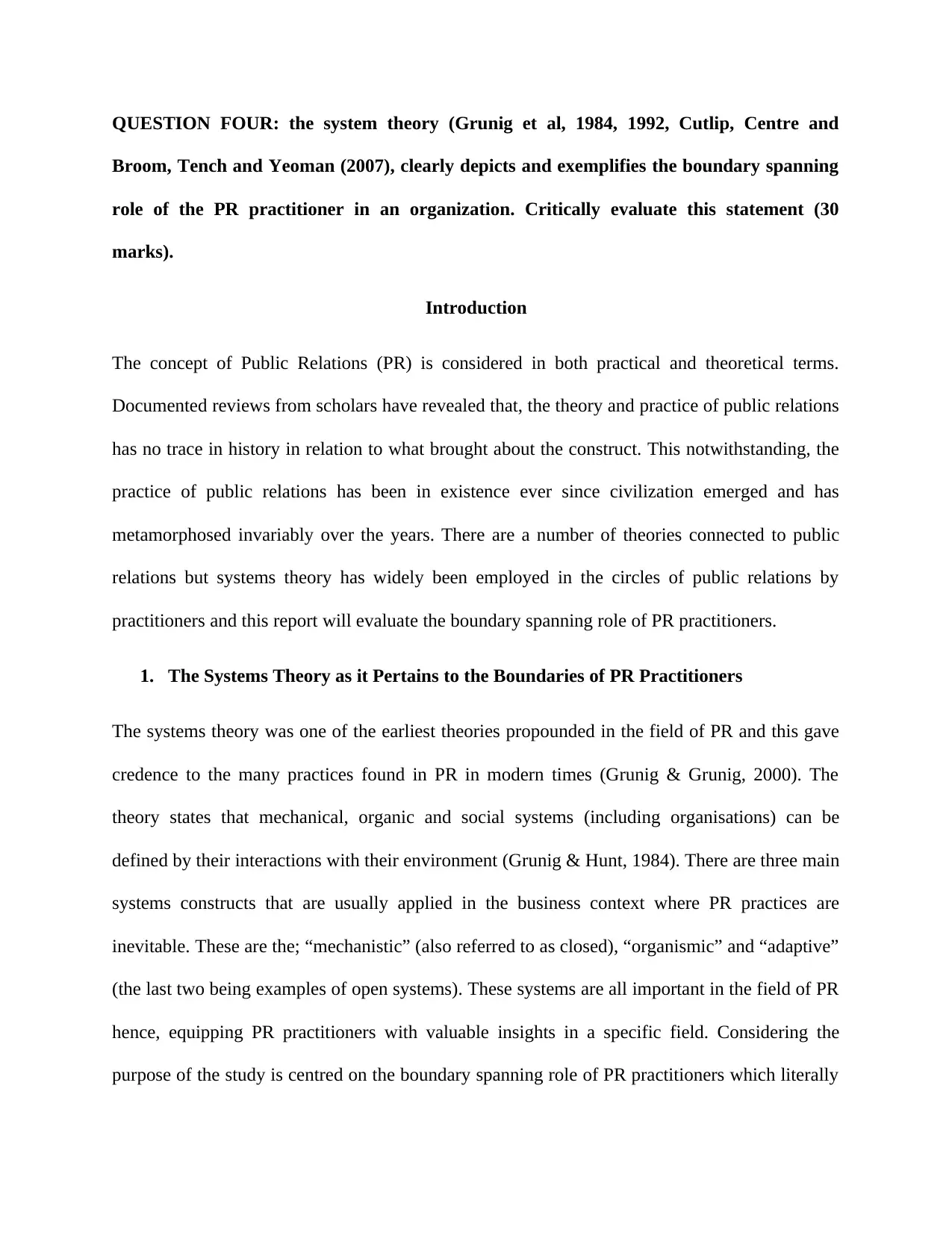
QUESTION FOUR: the system theory (Grunig et al, 1984, 1992, Cutlip, Centre and
Broom, Tench and Yeoman (2007), clearly depicts and exemplifies the boundary spanning
role of the PR practitioner in an organization. Critically evaluate this statement (30
marks).
Introduction
The concept of Public Relations (PR) is considered in both practical and theoretical terms.
Documented reviews from scholars have revealed that, the theory and practice of public relations
has no trace in history in relation to what brought about the construct. This notwithstanding, the
practice of public relations has been in existence ever since civilization emerged and has
metamorphosed invariably over the years. There are a number of theories connected to public
relations but systems theory has widely been employed in the circles of public relations by
practitioners and this report will evaluate the boundary spanning role of PR practitioners.
1. The Systems Theory as it Pertains to the Boundaries of PR Practitioners
The systems theory was one of the earliest theories propounded in the field of PR and this gave
credence to the many practices found in PR in modern times (Grunig & Grunig, 2000). The
theory states that mechanical, organic and social systems (including organisations) can be
defined by their interactions with their environment (Grunig & Hunt, 1984). There are three main
systems constructs that are usually applied in the business context where PR practices are
inevitable. These are the; “mechanistic” (also referred to as closed), “organismic” and “adaptive”
(the last two being examples of open systems). These systems are all important in the field of PR
hence, equipping PR practitioners with valuable insights in a specific field. Considering the
purpose of the study is centred on the boundary spanning role of PR practitioners which literally
Broom, Tench and Yeoman (2007), clearly depicts and exemplifies the boundary spanning
role of the PR practitioner in an organization. Critically evaluate this statement (30
marks).
Introduction
The concept of Public Relations (PR) is considered in both practical and theoretical terms.
Documented reviews from scholars have revealed that, the theory and practice of public relations
has no trace in history in relation to what brought about the construct. This notwithstanding, the
practice of public relations has been in existence ever since civilization emerged and has
metamorphosed invariably over the years. There are a number of theories connected to public
relations but systems theory has widely been employed in the circles of public relations by
practitioners and this report will evaluate the boundary spanning role of PR practitioners.
1. The Systems Theory as it Pertains to the Boundaries of PR Practitioners
The systems theory was one of the earliest theories propounded in the field of PR and this gave
credence to the many practices found in PR in modern times (Grunig & Grunig, 2000). The
theory states that mechanical, organic and social systems (including organisations) can be
defined by their interactions with their environment (Grunig & Hunt, 1984). There are three main
systems constructs that are usually applied in the business context where PR practices are
inevitable. These are the; “mechanistic” (also referred to as closed), “organismic” and “adaptive”
(the last two being examples of open systems). These systems are all important in the field of PR
hence, equipping PR practitioners with valuable insights in a specific field. Considering the
purpose of the study is centred on the boundary spanning role of PR practitioners which literally
Paraphrase This Document
Need a fresh take? Get an instant paraphrase of this document with our AI Paraphraser
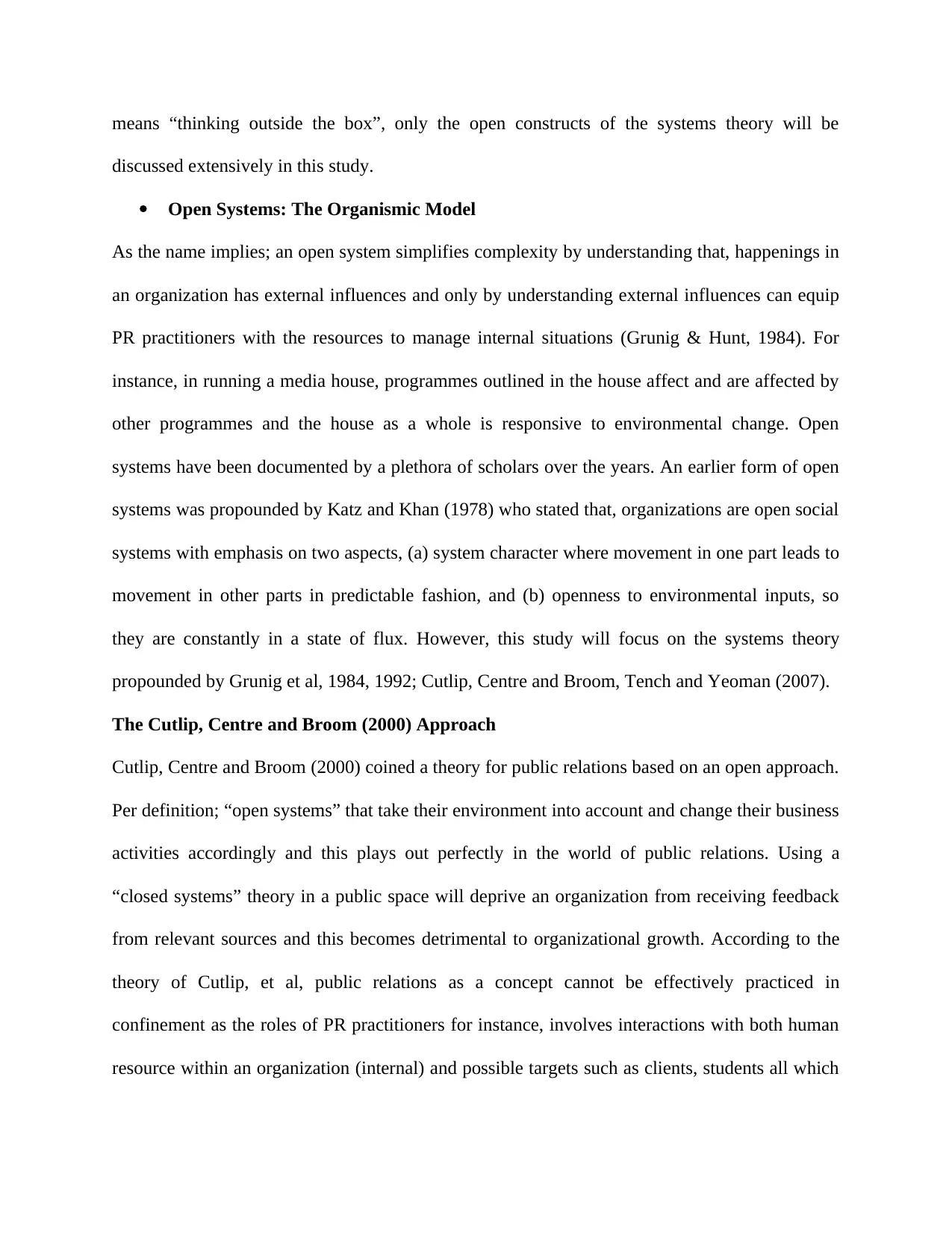
means “thinking outside the box”, only the open constructs of the systems theory will be
discussed extensively in this study.
Open Systems: The Organismic Model
As the name implies; an open system simplifies complexity by understanding that, happenings in
an organization has external influences and only by understanding external influences can equip
PR practitioners with the resources to manage internal situations (Grunig & Hunt, 1984). For
instance, in running a media house, programmes outlined in the house affect and are affected by
other programmes and the house as a whole is responsive to environmental change. Open
systems have been documented by a plethora of scholars over the years. An earlier form of open
systems was propounded by Katz and Khan (1978) who stated that, organizations are open social
systems with emphasis on two aspects, (a) system character where movement in one part leads to
movement in other parts in predictable fashion, and (b) openness to environmental inputs, so
they are constantly in a state of flux. However, this study will focus on the systems theory
propounded by Grunig et al, 1984, 1992; Cutlip, Centre and Broom, Tench and Yeoman (2007).
The Cutlip, Centre and Broom (2000) Approach
Cutlip, Centre and Broom (2000) coined a theory for public relations based on an open approach.
Per definition; “open systems” that take their environment into account and change their business
activities accordingly and this plays out perfectly in the world of public relations. Using a
“closed systems” theory in a public space will deprive an organization from receiving feedback
from relevant sources and this becomes detrimental to organizational growth. According to the
theory of Cutlip, et al, public relations as a concept cannot be effectively practiced in
confinement as the roles of PR practitioners for instance, involves interactions with both human
resource within an organization (internal) and possible targets such as clients, students all which
discussed extensively in this study.
Open Systems: The Organismic Model
As the name implies; an open system simplifies complexity by understanding that, happenings in
an organization has external influences and only by understanding external influences can equip
PR practitioners with the resources to manage internal situations (Grunig & Hunt, 1984). For
instance, in running a media house, programmes outlined in the house affect and are affected by
other programmes and the house as a whole is responsive to environmental change. Open
systems have been documented by a plethora of scholars over the years. An earlier form of open
systems was propounded by Katz and Khan (1978) who stated that, organizations are open social
systems with emphasis on two aspects, (a) system character where movement in one part leads to
movement in other parts in predictable fashion, and (b) openness to environmental inputs, so
they are constantly in a state of flux. However, this study will focus on the systems theory
propounded by Grunig et al, 1984, 1992; Cutlip, Centre and Broom, Tench and Yeoman (2007).
The Cutlip, Centre and Broom (2000) Approach
Cutlip, Centre and Broom (2000) coined a theory for public relations based on an open approach.
Per definition; “open systems” that take their environment into account and change their business
activities accordingly and this plays out perfectly in the world of public relations. Using a
“closed systems” theory in a public space will deprive an organization from receiving feedback
from relevant sources and this becomes detrimental to organizational growth. According to the
theory of Cutlip, et al, public relations as a concept cannot be effectively practiced in
confinement as the roles of PR practitioners for instance, involves interactions with both human
resource within an organization (internal) and possible targets such as clients, students all which
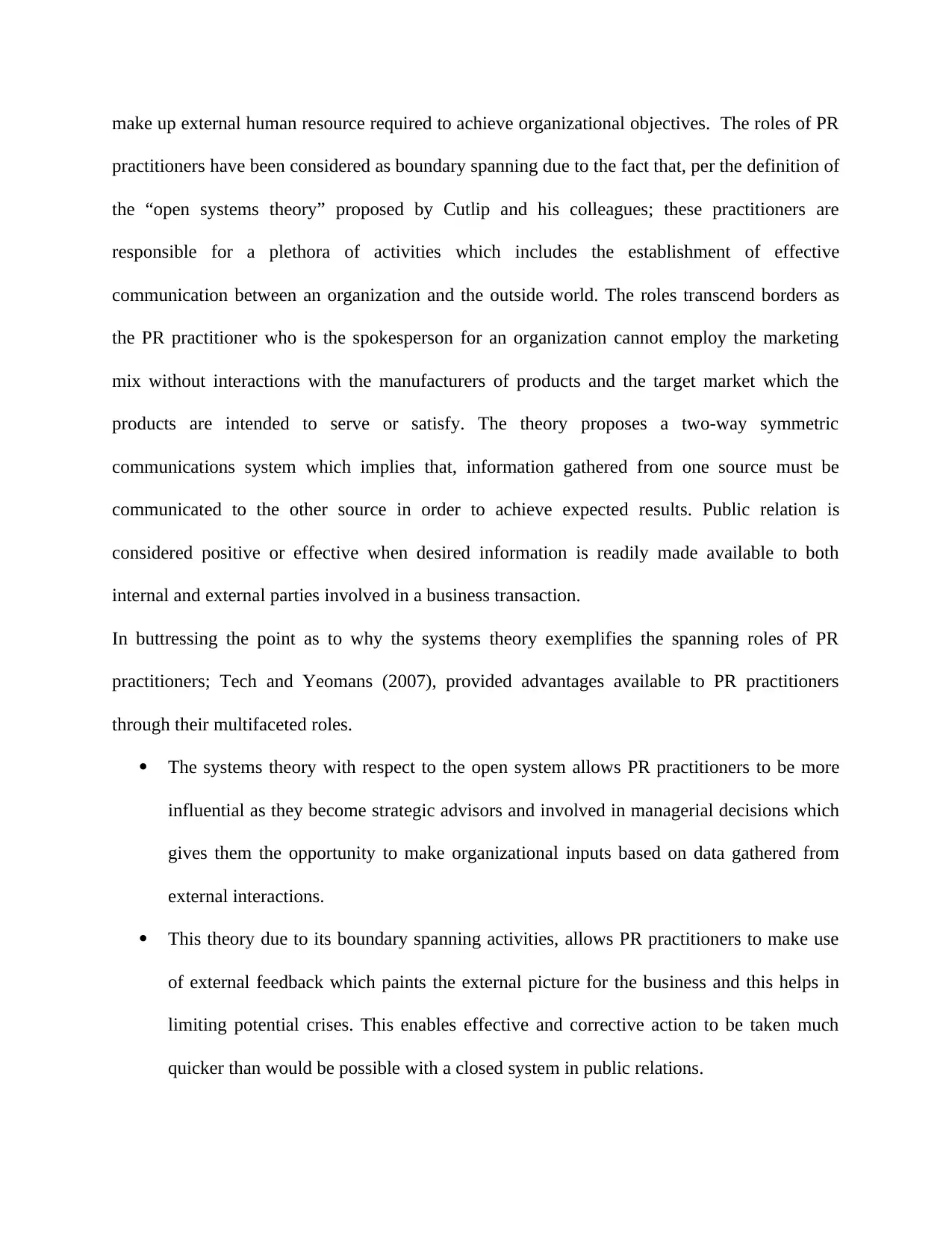
make up external human resource required to achieve organizational objectives. The roles of PR
practitioners have been considered as boundary spanning due to the fact that, per the definition of
the “open systems theory” proposed by Cutlip and his colleagues; these practitioners are
responsible for a plethora of activities which includes the establishment of effective
communication between an organization and the outside world. The roles transcend borders as
the PR practitioner who is the spokesperson for an organization cannot employ the marketing
mix without interactions with the manufacturers of products and the target market which the
products are intended to serve or satisfy. The theory proposes a two-way symmetric
communications system which implies that, information gathered from one source must be
communicated to the other source in order to achieve expected results. Public relation is
considered positive or effective when desired information is readily made available to both
internal and external parties involved in a business transaction.
In buttressing the point as to why the systems theory exemplifies the spanning roles of PR
practitioners; Tech and Yeomans (2007), provided advantages available to PR practitioners
through their multifaceted roles.
The systems theory with respect to the open system allows PR practitioners to be more
influential as they become strategic advisors and involved in managerial decisions which
gives them the opportunity to make organizational inputs based on data gathered from
external interactions.
This theory due to its boundary spanning activities, allows PR practitioners to make use
of external feedback which paints the external picture for the business and this helps in
limiting potential crises. This enables effective and corrective action to be taken much
quicker than would be possible with a closed system in public relations.
practitioners have been considered as boundary spanning due to the fact that, per the definition of
the “open systems theory” proposed by Cutlip and his colleagues; these practitioners are
responsible for a plethora of activities which includes the establishment of effective
communication between an organization and the outside world. The roles transcend borders as
the PR practitioner who is the spokesperson for an organization cannot employ the marketing
mix without interactions with the manufacturers of products and the target market which the
products are intended to serve or satisfy. The theory proposes a two-way symmetric
communications system which implies that, information gathered from one source must be
communicated to the other source in order to achieve expected results. Public relation is
considered positive or effective when desired information is readily made available to both
internal and external parties involved in a business transaction.
In buttressing the point as to why the systems theory exemplifies the spanning roles of PR
practitioners; Tech and Yeomans (2007), provided advantages available to PR practitioners
through their multifaceted roles.
The systems theory with respect to the open system allows PR practitioners to be more
influential as they become strategic advisors and involved in managerial decisions which
gives them the opportunity to make organizational inputs based on data gathered from
external interactions.
This theory due to its boundary spanning activities, allows PR practitioners to make use
of external feedback which paints the external picture for the business and this helps in
limiting potential crises. This enables effective and corrective action to be taken much
quicker than would be possible with a closed system in public relations.
⊘ This is a preview!⊘
Do you want full access?
Subscribe today to unlock all pages.

Trusted by 1+ million students worldwide
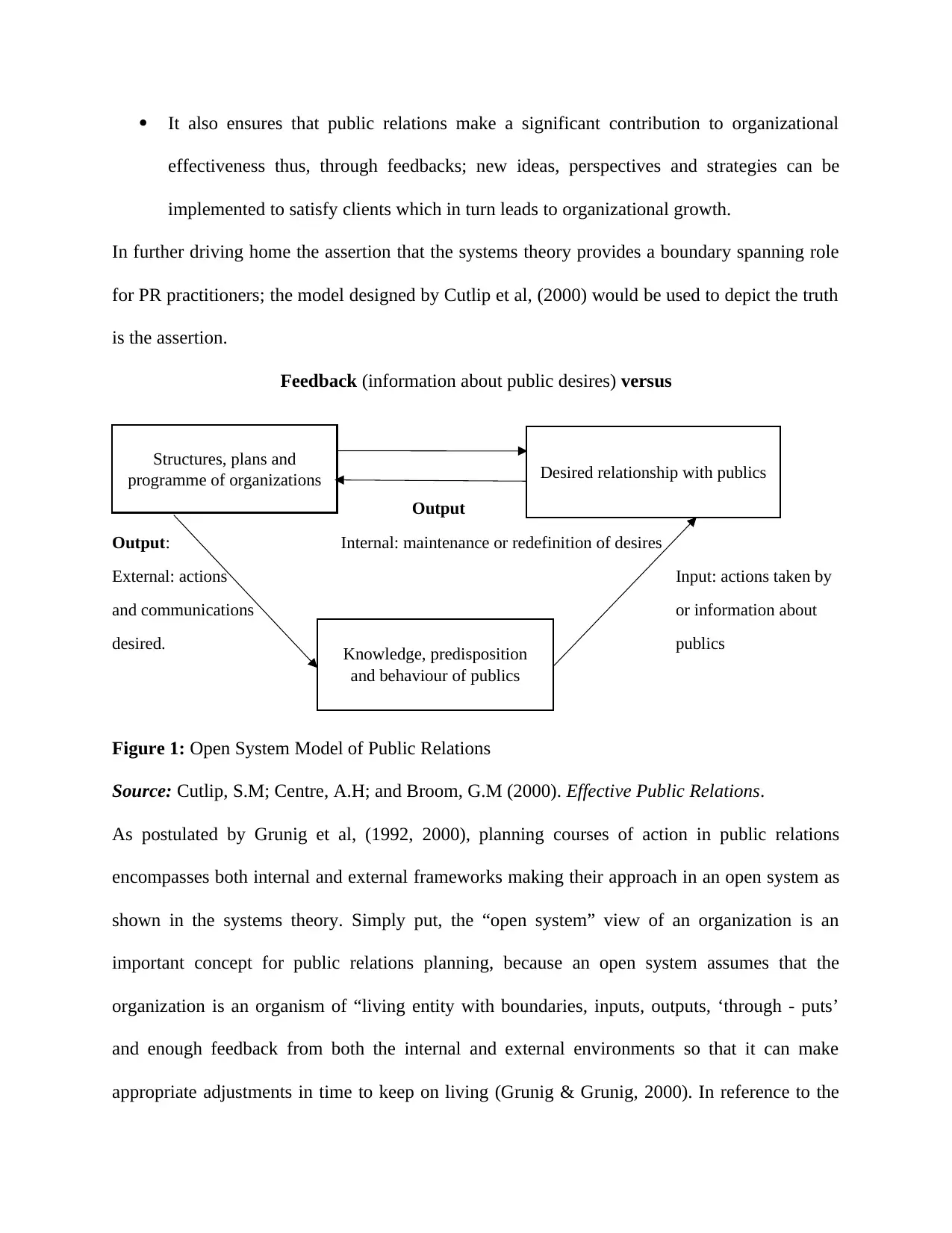
It also ensures that public relations make a significant contribution to organizational
effectiveness thus, through feedbacks; new ideas, perspectives and strategies can be
implemented to satisfy clients which in turn leads to organizational growth.
In further driving home the assertion that the systems theory provides a boundary spanning role
for PR practitioners; the model designed by Cutlip et al, (2000) would be used to depict the truth
is the assertion.
Feedback (information about public desires) versus
Output
Output: Internal: maintenance or redefinition of desires
External: actions Input: actions taken by
and communications or information about
desired. publics
Figure 1: Open System Model of Public Relations
Source: Cutlip, S.M; Centre, A.H; and Broom, G.M (2000). Effective Public Relations.
As postulated by Grunig et al, (1992, 2000), planning courses of action in public relations
encompasses both internal and external frameworks making their approach in an open system as
shown in the systems theory. Simply put, the “open system” view of an organization is an
important concept for public relations planning, because an open system assumes that the
organization is an organism of “living entity with boundaries, inputs, outputs, ‘through - puts’
and enough feedback from both the internal and external environments so that it can make
appropriate adjustments in time to keep on living (Grunig & Grunig, 2000). In reference to the
Structures, plans and
programme of organizations Desired relationship with publics
Knowledge, predisposition
and behaviour of publics
effectiveness thus, through feedbacks; new ideas, perspectives and strategies can be
implemented to satisfy clients which in turn leads to organizational growth.
In further driving home the assertion that the systems theory provides a boundary spanning role
for PR practitioners; the model designed by Cutlip et al, (2000) would be used to depict the truth
is the assertion.
Feedback (information about public desires) versus
Output
Output: Internal: maintenance or redefinition of desires
External: actions Input: actions taken by
and communications or information about
desired. publics
Figure 1: Open System Model of Public Relations
Source: Cutlip, S.M; Centre, A.H; and Broom, G.M (2000). Effective Public Relations.
As postulated by Grunig et al, (1992, 2000), planning courses of action in public relations
encompasses both internal and external frameworks making their approach in an open system as
shown in the systems theory. Simply put, the “open system” view of an organization is an
important concept for public relations planning, because an open system assumes that the
organization is an organism of “living entity with boundaries, inputs, outputs, ‘through - puts’
and enough feedback from both the internal and external environments so that it can make
appropriate adjustments in time to keep on living (Grunig & Grunig, 2000). In reference to the
Structures, plans and
programme of organizations Desired relationship with publics
Knowledge, predisposition
and behaviour of publics
Paraphrase This Document
Need a fresh take? Get an instant paraphrase of this document with our AI Paraphraser
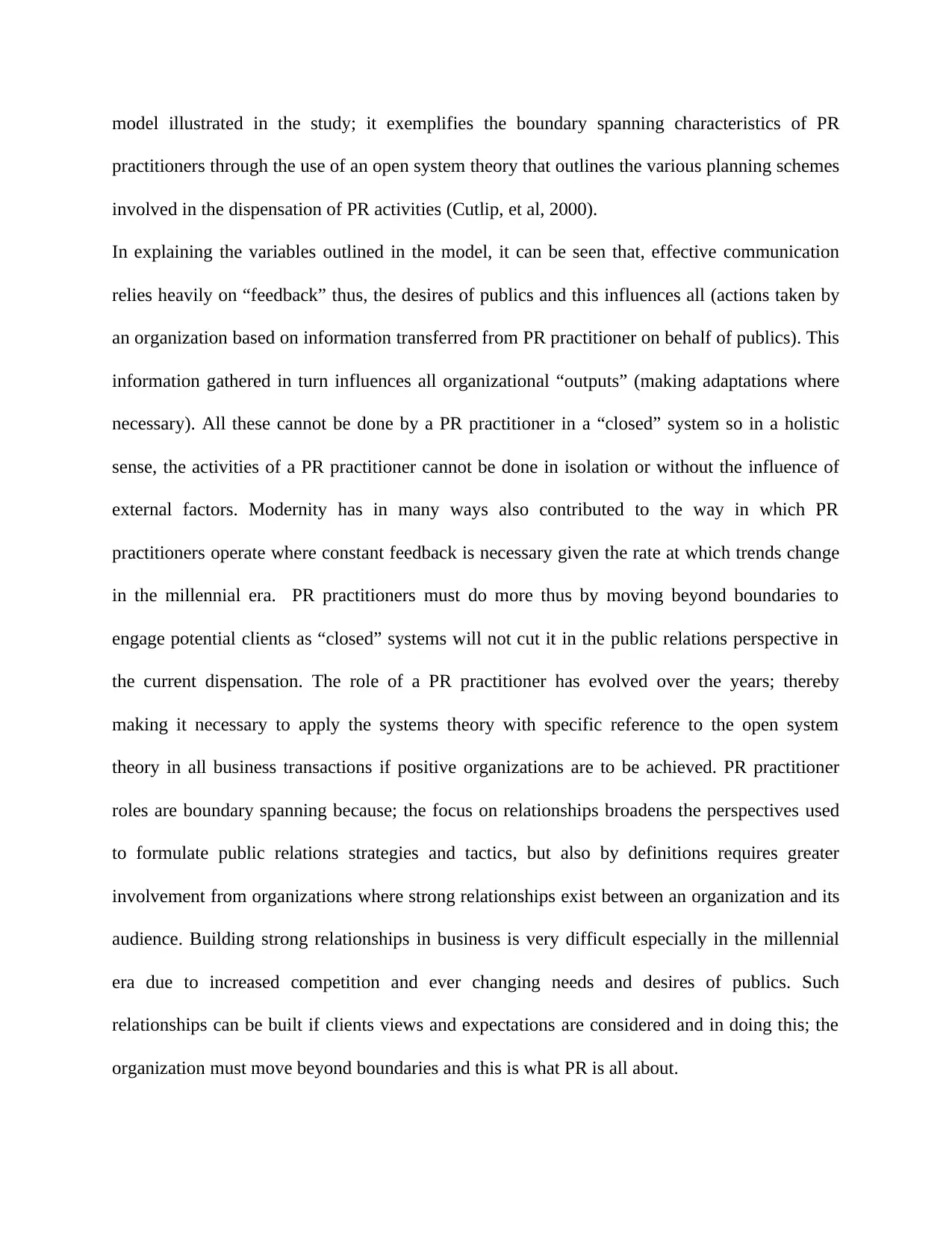
model illustrated in the study; it exemplifies the boundary spanning characteristics of PR
practitioners through the use of an open system theory that outlines the various planning schemes
involved in the dispensation of PR activities (Cutlip, et al, 2000).
In explaining the variables outlined in the model, it can be seen that, effective communication
relies heavily on “feedback” thus, the desires of publics and this influences all (actions taken by
an organization based on information transferred from PR practitioner on behalf of publics). This
information gathered in turn influences all organizational “outputs” (making adaptations where
necessary). All these cannot be done by a PR practitioner in a “closed” system so in a holistic
sense, the activities of a PR practitioner cannot be done in isolation or without the influence of
external factors. Modernity has in many ways also contributed to the way in which PR
practitioners operate where constant feedback is necessary given the rate at which trends change
in the millennial era. PR practitioners must do more thus by moving beyond boundaries to
engage potential clients as “closed” systems will not cut it in the public relations perspective in
the current dispensation. The role of a PR practitioner has evolved over the years; thereby
making it necessary to apply the systems theory with specific reference to the open system
theory in all business transactions if positive organizations are to be achieved. PR practitioner
roles are boundary spanning because; the focus on relationships broadens the perspectives used
to formulate public relations strategies and tactics, but also by definitions requires greater
involvement from organizations where strong relationships exist between an organization and its
audience. Building strong relationships in business is very difficult especially in the millennial
era due to increased competition and ever changing needs and desires of publics. Such
relationships can be built if clients views and expectations are considered and in doing this; the
organization must move beyond boundaries and this is what PR is all about.
practitioners through the use of an open system theory that outlines the various planning schemes
involved in the dispensation of PR activities (Cutlip, et al, 2000).
In explaining the variables outlined in the model, it can be seen that, effective communication
relies heavily on “feedback” thus, the desires of publics and this influences all (actions taken by
an organization based on information transferred from PR practitioner on behalf of publics). This
information gathered in turn influences all organizational “outputs” (making adaptations where
necessary). All these cannot be done by a PR practitioner in a “closed” system so in a holistic
sense, the activities of a PR practitioner cannot be done in isolation or without the influence of
external factors. Modernity has in many ways also contributed to the way in which PR
practitioners operate where constant feedback is necessary given the rate at which trends change
in the millennial era. PR practitioners must do more thus by moving beyond boundaries to
engage potential clients as “closed” systems will not cut it in the public relations perspective in
the current dispensation. The role of a PR practitioner has evolved over the years; thereby
making it necessary to apply the systems theory with specific reference to the open system
theory in all business transactions if positive organizations are to be achieved. PR practitioner
roles are boundary spanning because; the focus on relationships broadens the perspectives used
to formulate public relations strategies and tactics, but also by definitions requires greater
involvement from organizations where strong relationships exist between an organization and its
audience. Building strong relationships in business is very difficult especially in the millennial
era due to increased competition and ever changing needs and desires of publics. Such
relationships can be built if clients views and expectations are considered and in doing this; the
organization must move beyond boundaries and this is what PR is all about.
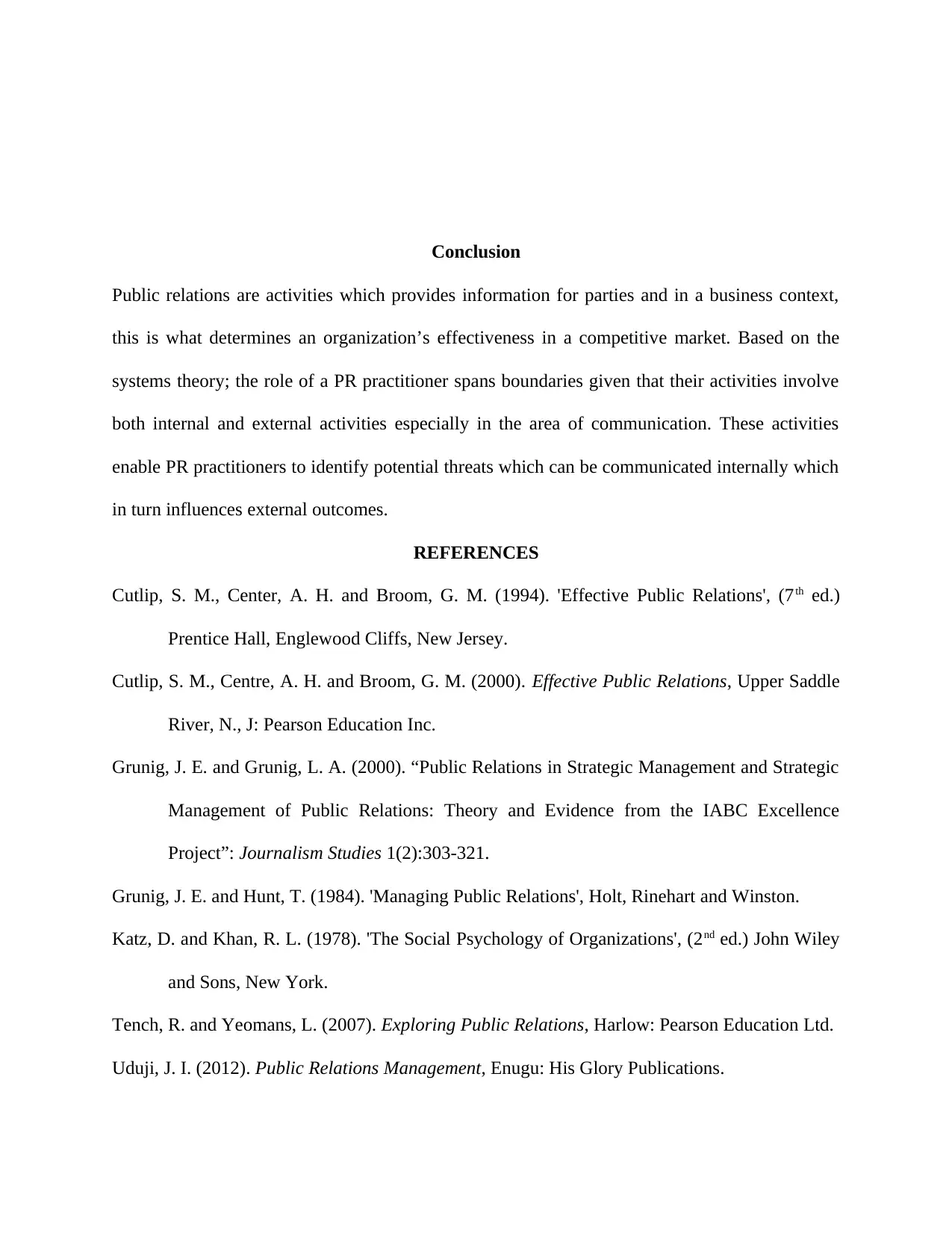
Conclusion
Public relations are activities which provides information for parties and in a business context,
this is what determines an organization’s effectiveness in a competitive market. Based on the
systems theory; the role of a PR practitioner spans boundaries given that their activities involve
both internal and external activities especially in the area of communication. These activities
enable PR practitioners to identify potential threats which can be communicated internally which
in turn influences external outcomes.
REFERENCES
Cutlip, S. M., Center, A. H. and Broom, G. M. (1994). 'Effective Public Relations', (7th ed.)
Prentice Hall, Englewood Cliffs, New Jersey.
Cutlip, S. M., Centre, A. H. and Broom, G. M. (2000). Effective Public Relations, Upper Saddle
River, N., J: Pearson Education Inc.
Grunig, J. E. and Grunig, L. A. (2000). “Public Relations in Strategic Management and Strategic
Management of Public Relations: Theory and Evidence from the IABC Excellence
Project”: Journalism Studies 1(2):303-321.
Grunig, J. E. and Hunt, T. (1984). 'Managing Public Relations', Holt, Rinehart and Winston.
Katz, D. and Khan, R. L. (1978). 'The Social Psychology of Organizations', (2nd ed.) John Wiley
and Sons, New York.
Tench, R. and Yeomans, L. (2007). Exploring Public Relations, Harlow: Pearson Education Ltd.
Uduji, J. I. (2012). Public Relations Management, Enugu: His Glory Publications.
Public relations are activities which provides information for parties and in a business context,
this is what determines an organization’s effectiveness in a competitive market. Based on the
systems theory; the role of a PR practitioner spans boundaries given that their activities involve
both internal and external activities especially in the area of communication. These activities
enable PR practitioners to identify potential threats which can be communicated internally which
in turn influences external outcomes.
REFERENCES
Cutlip, S. M., Center, A. H. and Broom, G. M. (1994). 'Effective Public Relations', (7th ed.)
Prentice Hall, Englewood Cliffs, New Jersey.
Cutlip, S. M., Centre, A. H. and Broom, G. M. (2000). Effective Public Relations, Upper Saddle
River, N., J: Pearson Education Inc.
Grunig, J. E. and Grunig, L. A. (2000). “Public Relations in Strategic Management and Strategic
Management of Public Relations: Theory and Evidence from the IABC Excellence
Project”: Journalism Studies 1(2):303-321.
Grunig, J. E. and Hunt, T. (1984). 'Managing Public Relations', Holt, Rinehart and Winston.
Katz, D. and Khan, R. L. (1978). 'The Social Psychology of Organizations', (2nd ed.) John Wiley
and Sons, New York.
Tench, R. and Yeomans, L. (2007). Exploring Public Relations, Harlow: Pearson Education Ltd.
Uduji, J. I. (2012). Public Relations Management, Enugu: His Glory Publications.
⊘ This is a preview!⊘
Do you want full access?
Subscribe today to unlock all pages.

Trusted by 1+ million students worldwide
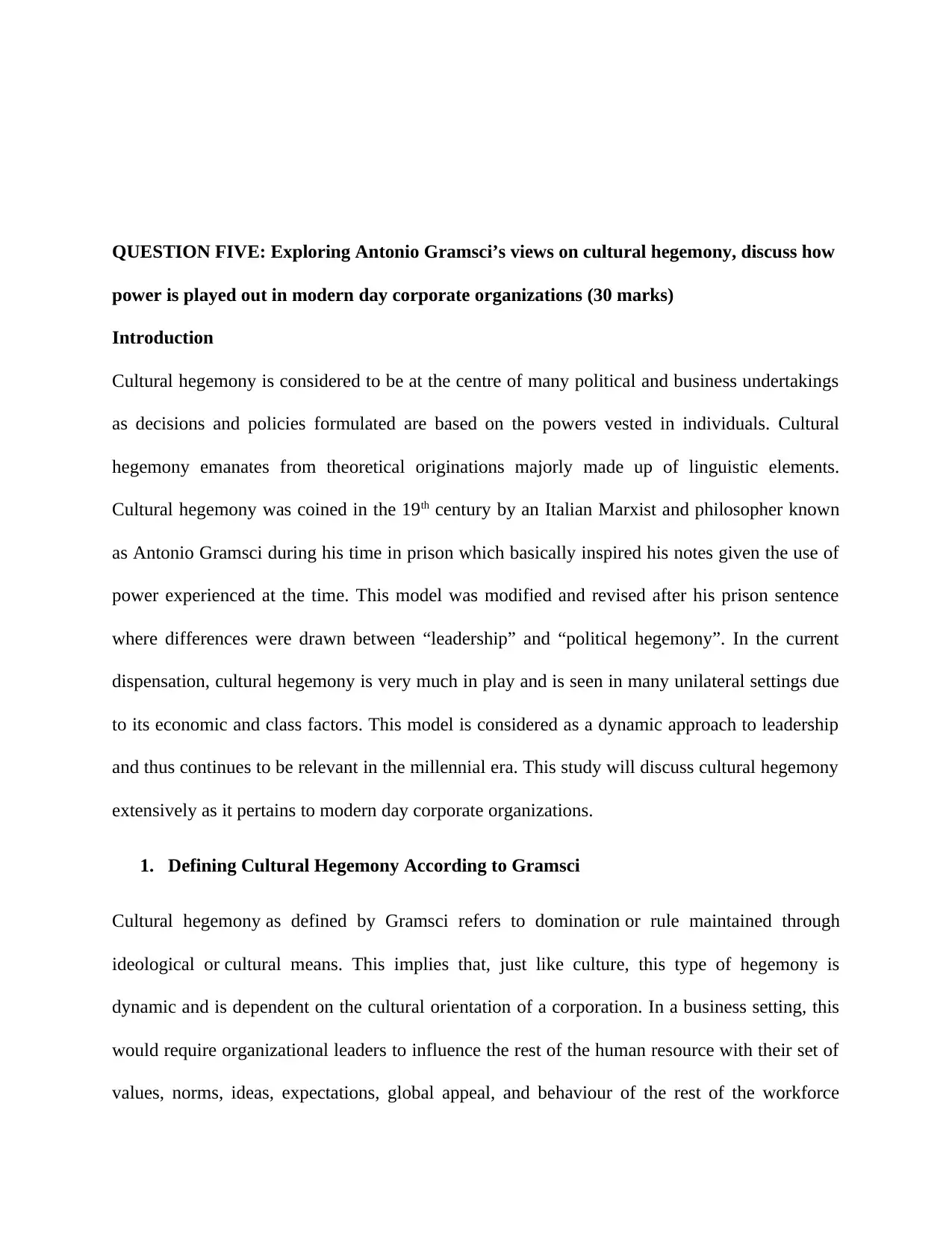
QUESTION FIVE: Exploring Antonio Gramsci’s views on cultural hegemony, discuss how
power is played out in modern day corporate organizations (30 marks)
Introduction
Cultural hegemony is considered to be at the centre of many political and business undertakings
as decisions and policies formulated are based on the powers vested in individuals. Cultural
hegemony emanates from theoretical originations majorly made up of linguistic elements.
Cultural hegemony was coined in the 19th century by an Italian Marxist and philosopher known
as Antonio Gramsci during his time in prison which basically inspired his notes given the use of
power experienced at the time. This model was modified and revised after his prison sentence
where differences were drawn between “leadership” and “political hegemony”. In the current
dispensation, cultural hegemony is very much in play and is seen in many unilateral settings due
to its economic and class factors. This model is considered as a dynamic approach to leadership
and thus continues to be relevant in the millennial era. This study will discuss cultural hegemony
extensively as it pertains to modern day corporate organizations.
1. Defining Cultural Hegemony According to Gramsci
Cultural hegemony as defined by Gramsci refers to domination or rule maintained through
ideological or cultural means. This implies that, just like culture, this type of hegemony is
dynamic and is dependent on the cultural orientation of a corporation. In a business setting, this
would require organizational leaders to influence the rest of the human resource with their set of
values, norms, ideas, expectations, global appeal, and behaviour of the rest of the workforce
power is played out in modern day corporate organizations (30 marks)
Introduction
Cultural hegemony is considered to be at the centre of many political and business undertakings
as decisions and policies formulated are based on the powers vested in individuals. Cultural
hegemony emanates from theoretical originations majorly made up of linguistic elements.
Cultural hegemony was coined in the 19th century by an Italian Marxist and philosopher known
as Antonio Gramsci during his time in prison which basically inspired his notes given the use of
power experienced at the time. This model was modified and revised after his prison sentence
where differences were drawn between “leadership” and “political hegemony”. In the current
dispensation, cultural hegemony is very much in play and is seen in many unilateral settings due
to its economic and class factors. This model is considered as a dynamic approach to leadership
and thus continues to be relevant in the millennial era. This study will discuss cultural hegemony
extensively as it pertains to modern day corporate organizations.
1. Defining Cultural Hegemony According to Gramsci
Cultural hegemony as defined by Gramsci refers to domination or rule maintained through
ideological or cultural means. This implies that, just like culture, this type of hegemony is
dynamic and is dependent on the cultural orientation of a corporation. In a business setting, this
would require organizational leaders to influence the rest of the human resource with their set of
values, norms, ideas, expectations, global appeal, and behaviour of the rest of the workforce
Paraphrase This Document
Need a fresh take? Get an instant paraphrase of this document with our AI Paraphraser
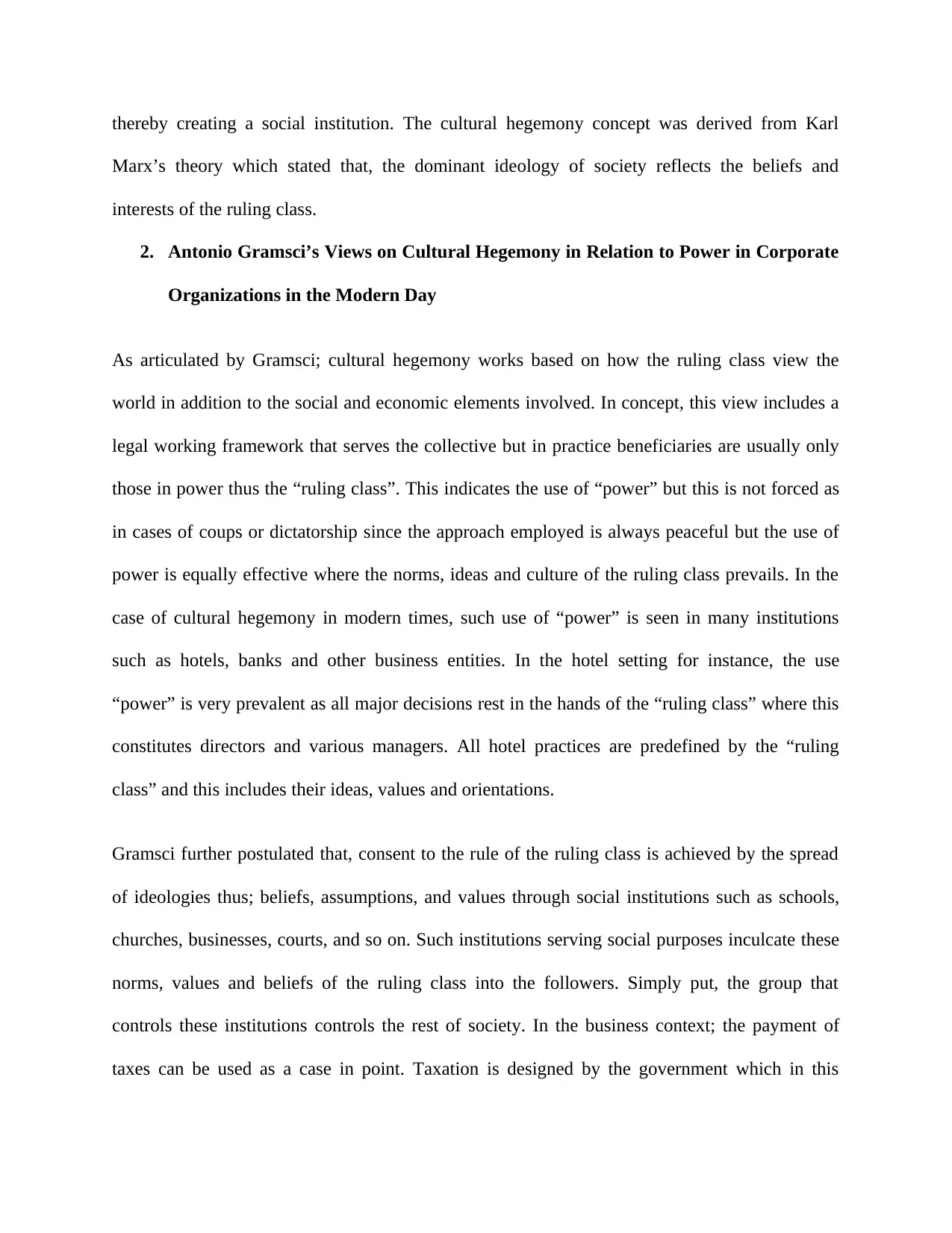
thereby creating a social institution. The cultural hegemony concept was derived from Karl
Marx’s theory which stated that, the dominant ideology of society reflects the beliefs and
interests of the ruling class.
2. Antonio Gramsci’s Views on Cultural Hegemony in Relation to Power in Corporate
Organizations in the Modern Day
As articulated by Gramsci; cultural hegemony works based on how the ruling class view the
world in addition to the social and economic elements involved. In concept, this view includes a
legal working framework that serves the collective but in practice beneficiaries are usually only
those in power thus the “ruling class”. This indicates the use of “power” but this is not forced as
in cases of coups or dictatorship since the approach employed is always peaceful but the use of
power is equally effective where the norms, ideas and culture of the ruling class prevails. In the
case of cultural hegemony in modern times, such use of “power” is seen in many institutions
such as hotels, banks and other business entities. In the hotel setting for instance, the use
“power” is very prevalent as all major decisions rest in the hands of the “ruling class” where this
constitutes directors and various managers. All hotel practices are predefined by the “ruling
class” and this includes their ideas, values and orientations.
Gramsci further postulated that, consent to the rule of the ruling class is achieved by the spread
of ideologies thus; beliefs, assumptions, and values through social institutions such as schools,
churches, businesses, courts, and so on. Such institutions serving social purposes inculcate these
norms, values and beliefs of the ruling class into the followers. Simply put, the group that
controls these institutions controls the rest of society. In the business context; the payment of
taxes can be used as a case in point. Taxation is designed by the government which in this
Marx’s theory which stated that, the dominant ideology of society reflects the beliefs and
interests of the ruling class.
2. Antonio Gramsci’s Views on Cultural Hegemony in Relation to Power in Corporate
Organizations in the Modern Day
As articulated by Gramsci; cultural hegemony works based on how the ruling class view the
world in addition to the social and economic elements involved. In concept, this view includes a
legal working framework that serves the collective but in practice beneficiaries are usually only
those in power thus the “ruling class”. This indicates the use of “power” but this is not forced as
in cases of coups or dictatorship since the approach employed is always peaceful but the use of
power is equally effective where the norms, ideas and culture of the ruling class prevails. In the
case of cultural hegemony in modern times, such use of “power” is seen in many institutions
such as hotels, banks and other business entities. In the hotel setting for instance, the use
“power” is very prevalent as all major decisions rest in the hands of the “ruling class” where this
constitutes directors and various managers. All hotel practices are predefined by the “ruling
class” and this includes their ideas, values and orientations.
Gramsci further postulated that, consent to the rule of the ruling class is achieved by the spread
of ideologies thus; beliefs, assumptions, and values through social institutions such as schools,
churches, businesses, courts, and so on. Such institutions serving social purposes inculcate these
norms, values and beliefs of the ruling class into the followers. Simply put, the group that
controls these institutions controls the rest of society. In the business context; the payment of
taxes can be used as a case in point. Taxation is designed by the government which in this
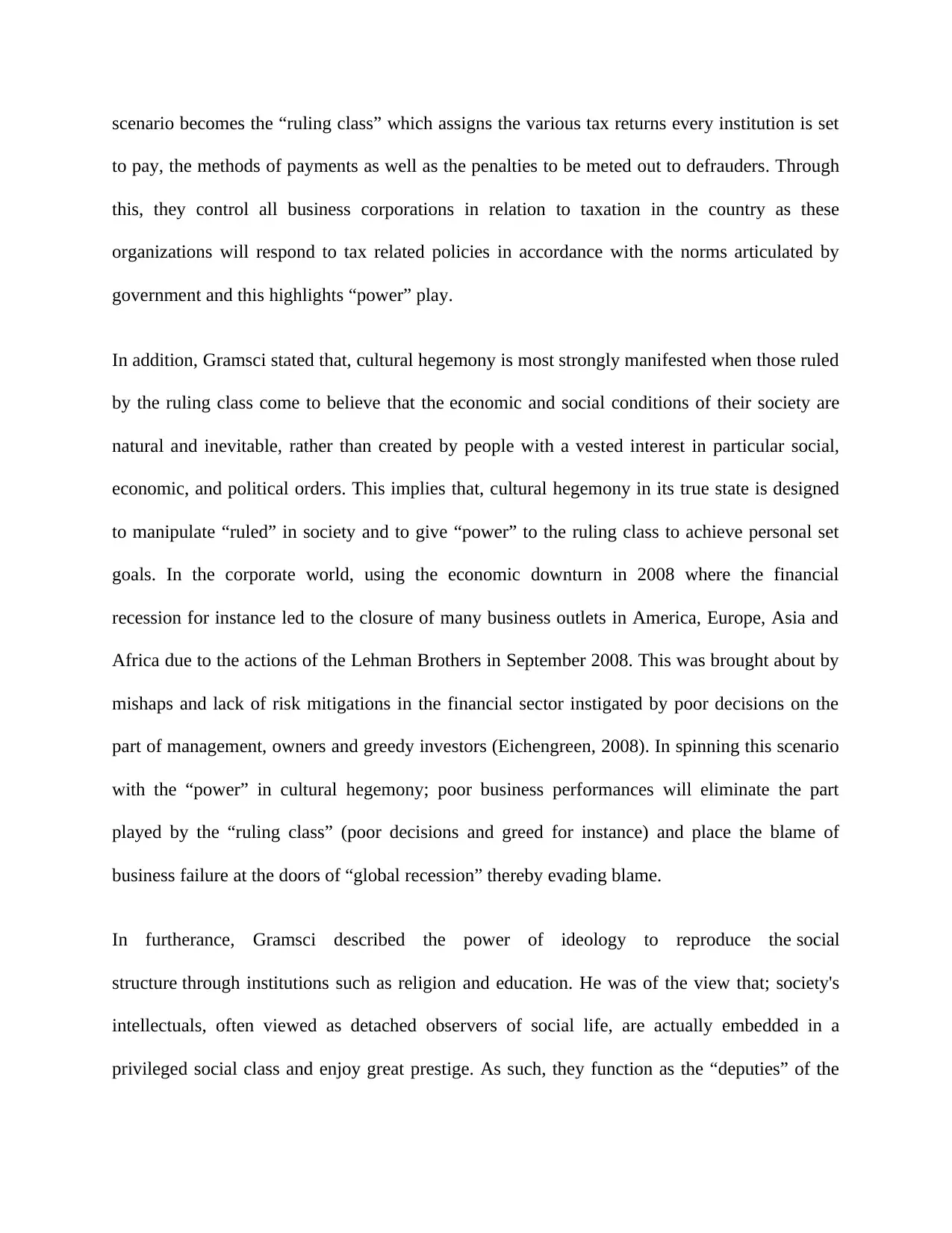
scenario becomes the “ruling class” which assigns the various tax returns every institution is set
to pay, the methods of payments as well as the penalties to be meted out to defrauders. Through
this, they control all business corporations in relation to taxation in the country as these
organizations will respond to tax related policies in accordance with the norms articulated by
government and this highlights “power” play.
In addition, Gramsci stated that, cultural hegemony is most strongly manifested when those ruled
by the ruling class come to believe that the economic and social conditions of their society are
natural and inevitable, rather than created by people with a vested interest in particular social,
economic, and political orders. This implies that, cultural hegemony in its true state is designed
to manipulate “ruled” in society and to give “power” to the ruling class to achieve personal set
goals. In the corporate world, using the economic downturn in 2008 where the financial
recession for instance led to the closure of many business outlets in America, Europe, Asia and
Africa due to the actions of the Lehman Brothers in September 2008. This was brought about by
mishaps and lack of risk mitigations in the financial sector instigated by poor decisions on the
part of management, owners and greedy investors (Eichengreen, 2008). In spinning this scenario
with the “power” in cultural hegemony; poor business performances will eliminate the part
played by the “ruling class” (poor decisions and greed for instance) and place the blame of
business failure at the doors of “global recession” thereby evading blame.
In furtherance, Gramsci described the power of ideology to reproduce the social
structure through institutions such as religion and education. He was of the view that; society's
intellectuals, often viewed as detached observers of social life, are actually embedded in a
privileged social class and enjoy great prestige. As such, they function as the “deputies” of the
to pay, the methods of payments as well as the penalties to be meted out to defrauders. Through
this, they control all business corporations in relation to taxation in the country as these
organizations will respond to tax related policies in accordance with the norms articulated by
government and this highlights “power” play.
In addition, Gramsci stated that, cultural hegemony is most strongly manifested when those ruled
by the ruling class come to believe that the economic and social conditions of their society are
natural and inevitable, rather than created by people with a vested interest in particular social,
economic, and political orders. This implies that, cultural hegemony in its true state is designed
to manipulate “ruled” in society and to give “power” to the ruling class to achieve personal set
goals. In the corporate world, using the economic downturn in 2008 where the financial
recession for instance led to the closure of many business outlets in America, Europe, Asia and
Africa due to the actions of the Lehman Brothers in September 2008. This was brought about by
mishaps and lack of risk mitigations in the financial sector instigated by poor decisions on the
part of management, owners and greedy investors (Eichengreen, 2008). In spinning this scenario
with the “power” in cultural hegemony; poor business performances will eliminate the part
played by the “ruling class” (poor decisions and greed for instance) and place the blame of
business failure at the doors of “global recession” thereby evading blame.
In furtherance, Gramsci described the power of ideology to reproduce the social
structure through institutions such as religion and education. He was of the view that; society's
intellectuals, often viewed as detached observers of social life, are actually embedded in a
privileged social class and enjoy great prestige. As such, they function as the “deputies” of the
⊘ This is a preview!⊘
Do you want full access?
Subscribe today to unlock all pages.

Trusted by 1+ million students worldwide
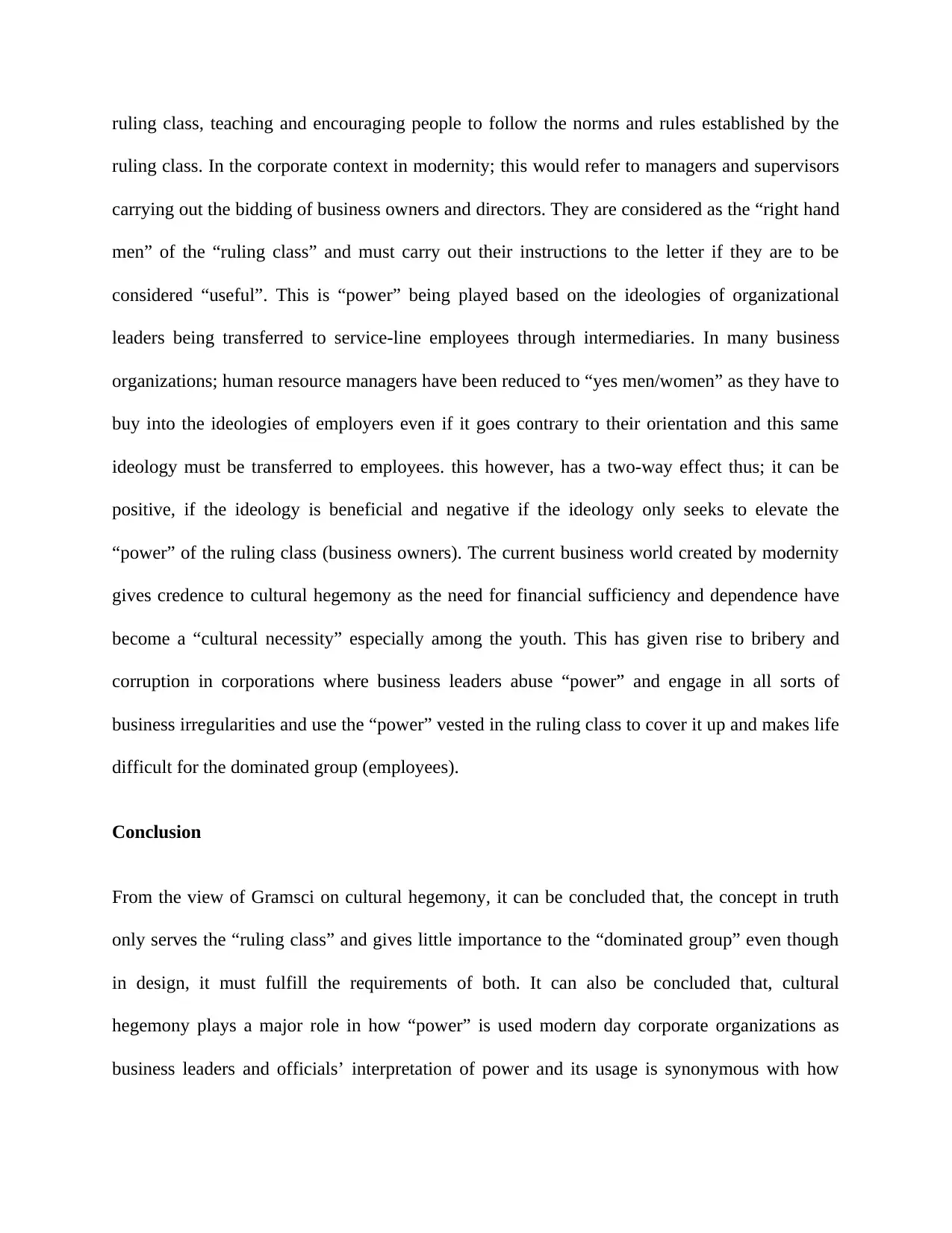
ruling class, teaching and encouraging people to follow the norms and rules established by the
ruling class. In the corporate context in modernity; this would refer to managers and supervisors
carrying out the bidding of business owners and directors. They are considered as the “right hand
men” of the “ruling class” and must carry out their instructions to the letter if they are to be
considered “useful”. This is “power” being played based on the ideologies of organizational
leaders being transferred to service-line employees through intermediaries. In many business
organizations; human resource managers have been reduced to “yes men/women” as they have to
buy into the ideologies of employers even if it goes contrary to their orientation and this same
ideology must be transferred to employees. this however, has a two-way effect thus; it can be
positive, if the ideology is beneficial and negative if the ideology only seeks to elevate the
“power” of the ruling class (business owners). The current business world created by modernity
gives credence to cultural hegemony as the need for financial sufficiency and dependence have
become a “cultural necessity” especially among the youth. This has given rise to bribery and
corruption in corporations where business leaders abuse “power” and engage in all sorts of
business irregularities and use the “power” vested in the ruling class to cover it up and makes life
difficult for the dominated group (employees).
Conclusion
From the view of Gramsci on cultural hegemony, it can be concluded that, the concept in truth
only serves the “ruling class” and gives little importance to the “dominated group” even though
in design, it must fulfill the requirements of both. It can also be concluded that, cultural
hegemony plays a major role in how “power” is used modern day corporate organizations as
business leaders and officials’ interpretation of power and its usage is synonymous with how
ruling class. In the corporate context in modernity; this would refer to managers and supervisors
carrying out the bidding of business owners and directors. They are considered as the “right hand
men” of the “ruling class” and must carry out their instructions to the letter if they are to be
considered “useful”. This is “power” being played based on the ideologies of organizational
leaders being transferred to service-line employees through intermediaries. In many business
organizations; human resource managers have been reduced to “yes men/women” as they have to
buy into the ideologies of employers even if it goes contrary to their orientation and this same
ideology must be transferred to employees. this however, has a two-way effect thus; it can be
positive, if the ideology is beneficial and negative if the ideology only seeks to elevate the
“power” of the ruling class (business owners). The current business world created by modernity
gives credence to cultural hegemony as the need for financial sufficiency and dependence have
become a “cultural necessity” especially among the youth. This has given rise to bribery and
corruption in corporations where business leaders abuse “power” and engage in all sorts of
business irregularities and use the “power” vested in the ruling class to cover it up and makes life
difficult for the dominated group (employees).
Conclusion
From the view of Gramsci on cultural hegemony, it can be concluded that, the concept in truth
only serves the “ruling class” and gives little importance to the “dominated group” even though
in design, it must fulfill the requirements of both. It can also be concluded that, cultural
hegemony plays a major role in how “power” is used modern day corporate organizations as
business leaders and officials’ interpretation of power and its usage is synonymous with how
Paraphrase This Document
Need a fresh take? Get an instant paraphrase of this document with our AI Paraphraser
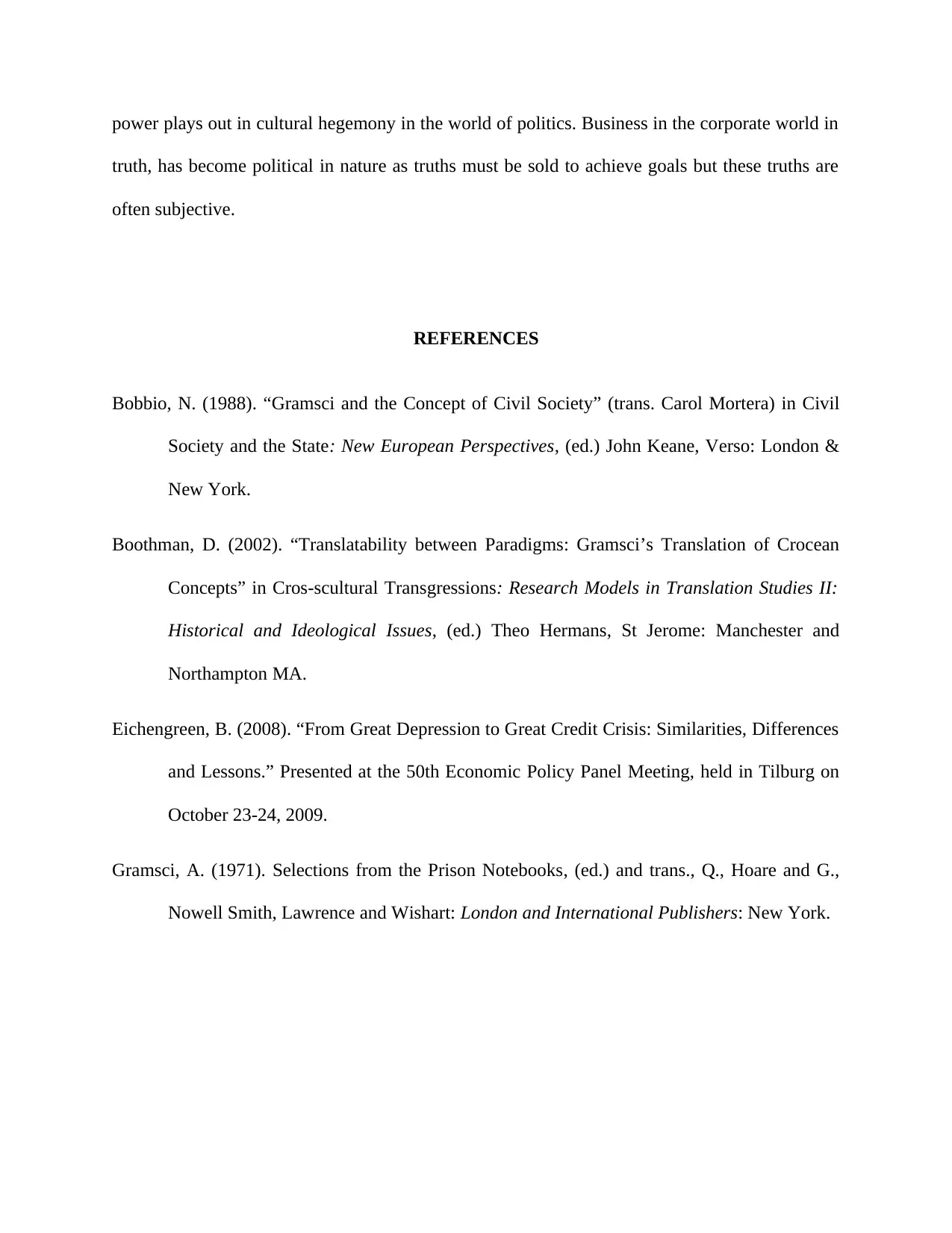
power plays out in cultural hegemony in the world of politics. Business in the corporate world in
truth, has become political in nature as truths must be sold to achieve goals but these truths are
often subjective.
REFERENCES
Bobbio, N. (1988). “Gramsci and the Concept of Civil Society” (trans. Carol Mortera) in Civil
Society and the State: New European Perspectives, (ed.) John Keane, Verso: London &
New York.
Boothman, D. (2002). “Translatability between Paradigms: Gramsci’s Translation of Crocean
Concepts” in Cros-scultural Transgressions: Research Models in Translation Studies II:
Historical and Ideological Issues, (ed.) Theo Hermans, St Jerome: Manchester and
Northampton MA.
Eichengreen, B. (2008). “From Great Depression to Great Credit Crisis: Similarities, Differences
and Lessons.” Presented at the 50th Economic Policy Panel Meeting, held in Tilburg on
October 23-24, 2009.
Gramsci, A. (1971). Selections from the Prison Notebooks, (ed.) and trans., Q., Hoare and G.,
Nowell Smith, Lawrence and Wishart: London and International Publishers: New York.
truth, has become political in nature as truths must be sold to achieve goals but these truths are
often subjective.
REFERENCES
Bobbio, N. (1988). “Gramsci and the Concept of Civil Society” (trans. Carol Mortera) in Civil
Society and the State: New European Perspectives, (ed.) John Keane, Verso: London &
New York.
Boothman, D. (2002). “Translatability between Paradigms: Gramsci’s Translation of Crocean
Concepts” in Cros-scultural Transgressions: Research Models in Translation Studies II:
Historical and Ideological Issues, (ed.) Theo Hermans, St Jerome: Manchester and
Northampton MA.
Eichengreen, B. (2008). “From Great Depression to Great Credit Crisis: Similarities, Differences
and Lessons.” Presented at the 50th Economic Policy Panel Meeting, held in Tilburg on
October 23-24, 2009.
Gramsci, A. (1971). Selections from the Prison Notebooks, (ed.) and trans., Q., Hoare and G.,
Nowell Smith, Lawrence and Wishart: London and International Publishers: New York.

⊘ This is a preview!⊘
Do you want full access?
Subscribe today to unlock all pages.

Trusted by 1+ million students worldwide
1 out of 12
Your All-in-One AI-Powered Toolkit for Academic Success.
+13062052269
info@desklib.com
Available 24*7 on WhatsApp / Email
![[object Object]](/_next/static/media/star-bottom.7253800d.svg)
Unlock your academic potential
Copyright © 2020–2025 A2Z Services. All Rights Reserved. Developed and managed by ZUCOL.